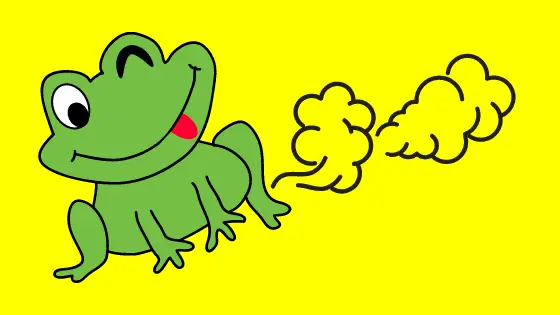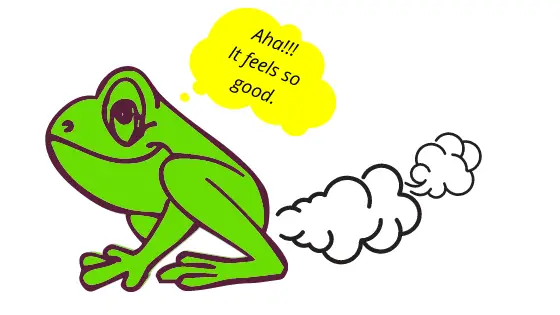Do Frogs fart? Why do Frogs fart?
Do Frogs Fart? Well, this is just a sudden question that arrives at the majority minds and they go search it on the internet.
So, Do Frogs Fart? Yes, frogs fart. It is seen that they release gasses through their anal end, and their sphincter muscles aren’t very strong enough to create the fart sound. So any gas escaping their anus may not cause enough audible sound vibrations.
What really does fart mean to you? Farts are simply gases that come out of the end opposite the mouth and its the result of a wide range of biological processes happening inside the intestine.
Farting is just to emit air from the anus that may or may not produce the sound.
Well! There are some animals that fart so bad and it smells the worst. African Bullfrogs and Horned Frogs do fart and it smells very bad but, you won’t hear the sound of their fart.
It’s alright to say that many farts are merely the byproduct of digestion, are smelly, and serve no real purpose.
But, it’s good to fart just in order to remove the waste excretory gases, or else it can disturb the digestive processes.
I am a Zoologist and so, I will try to answer it all in a very easily understandable Zoological point of view. So, just keep reading!

Do Frogs Fart? Probable Explanation!
Yes, frogs do fart. Fart in frogs is just the gradual release of gasses like ammonia, hydrogen, carbon dioxide, and maybe bit of methane gas from their body.
Farting in frogs is just a biological process which happens automatically without even the voluntary control of the frog.
It’s just a way to get rid of the unwanted gases from the frog’s digestive system.
It was seen that many of the frog species like the African Bullfrogs and Horned Frogs do fart and it smells very bad but, you won’t hear the sound of their fart.
The bad smell that comes out when they fart is actually due to the ammonia gas, with hydrogen release.
The microorganisms that are present in the frog’s digestive tract, including the stomach, intestine, and rectum can create hydrogen and carbon dioxide gasses when they breakdown the food.
We all know that frogs excrete their nitrogenous wastes as ammonium because they aren’t worried about conserving water. During the process of making ammonium after digesting the food, various gases are released.
It’s probable that a few of those unwanted gases only comes out of the frog’s body as a fart, which is natural.
The carbohydrate portions of the food that haven’t been fully digested in the stomach can reach the duodenum portion where bacteria convert part of that food into hydrogen and carbon dioxide gasses.
All that gas has to go somewhere. Some of it can be absorbed by the body.
But when too much of it gathers in the upper part of the intestine it puts pressure on the rectum portion and thus leads to its release from the cloaca.
Intestinal microbial richness is detected in the digestive tract of the farmland frogs, which is mostly contributed by numerous microbial species of Proteobacteria, Actinobacteria, Acidobacteria, and Planctomycetes.
Bacterial species like F. limnocharis and B. adenopleura, are seen more often, in the farmland frog’s digestive tract, mainly in the intestinal region.
Another source of excessive gas release is the breakdown of food by the intestinal bacteria. The bacteria produce the gas (primarily hydrogen and/or methane) when they digest foods.
Intestinal bacteria also primarily break down the sugars and nondigestible polysaccharides (for example, starch, cellulose), that have not been digested. Any extra gasses that are released also comes out as a fart.

Probable reasons why frogs fart
It has been seen that when a frog feeds on a beetle that can secrete toxic gases in order to save itself, can also cause in the release of such gasses in the frog’s stomach.
The release of such gases by the beetle is just a defensive mechanism to protect itself from the frog.
Those gasses create a disturbance in the frog’s digestive metabolism and thus needed to be removed from the body.
Thus, these gases come out as burp through the mouth or as fart through the anal end.
For example Bombardier beetle (Pheropsophus jessoensis) is one such beetle that can release a hot chemical spray when they feel danger.
One experiment conducted on a Japanese Common Toad (Bufo japonicus) where the toad was allowed to feed on a Bombardier beetle.
As soon as the toad had fed upon the beetle it entered the stomach of the frog where the beetle started releasing its chemical spray.
Researchers could hear the sound of the insect’s chemical spray inside the toad. Soon the toad started releasing those toxic gasses via. its mouth as burps.
The frog soon started appearing a bit drunk with seizures and fever. And after about 88 minutes later that toad vomited the beetle.
One interesting thing is that both the beetle and the frog remained unharmed.
This shows that the frogs release various gases to save themselves and also to get rid of any disturbance in its digestive system.
During the initial stage of digesting any food, it can release the extra gasses formed inside via. the mouth as burps. And, during the mid or final stages of digestion of food, the frog can release it via. its cloaca as farts.
Conclusion
Frogs are another species whose farting status is still uncertain if you talk about all of the frog species. It’s because only a few species were seen to fart so far.
For one thing, their sphincter muscles aren’t very strong, so any gas escaping their rear end may not cause enough vibration to be audible.
So, that’s also why you won’t hear the frog fart. They are silent farteurs.
They do release ammonia, hydrogen, and methane gasses when they fart. The smell seems like that, of course!
But yes, you can listen a frog to burp when they are okay with releasing gasses through their mouth. They often burp to warn their predators or to balance their body gasses.
